Menu Planning and Food Service Concepts
VerifiedAdded on 2020/01/28
|18
|6529
|387
Report
AI Summary
This report delves into the intricacies of menu planning and food service concepts, emphasizing the importance of recipe development, customer preferences, and effective service delivery methods. It outlines various factors influencing menu decisions, stages of product development, and recommendations for implementing new food concepts. The report concludes with a self-evaluation of the proposed food service concept, highlighting areas for improvement and innovation in the hospitality industry.
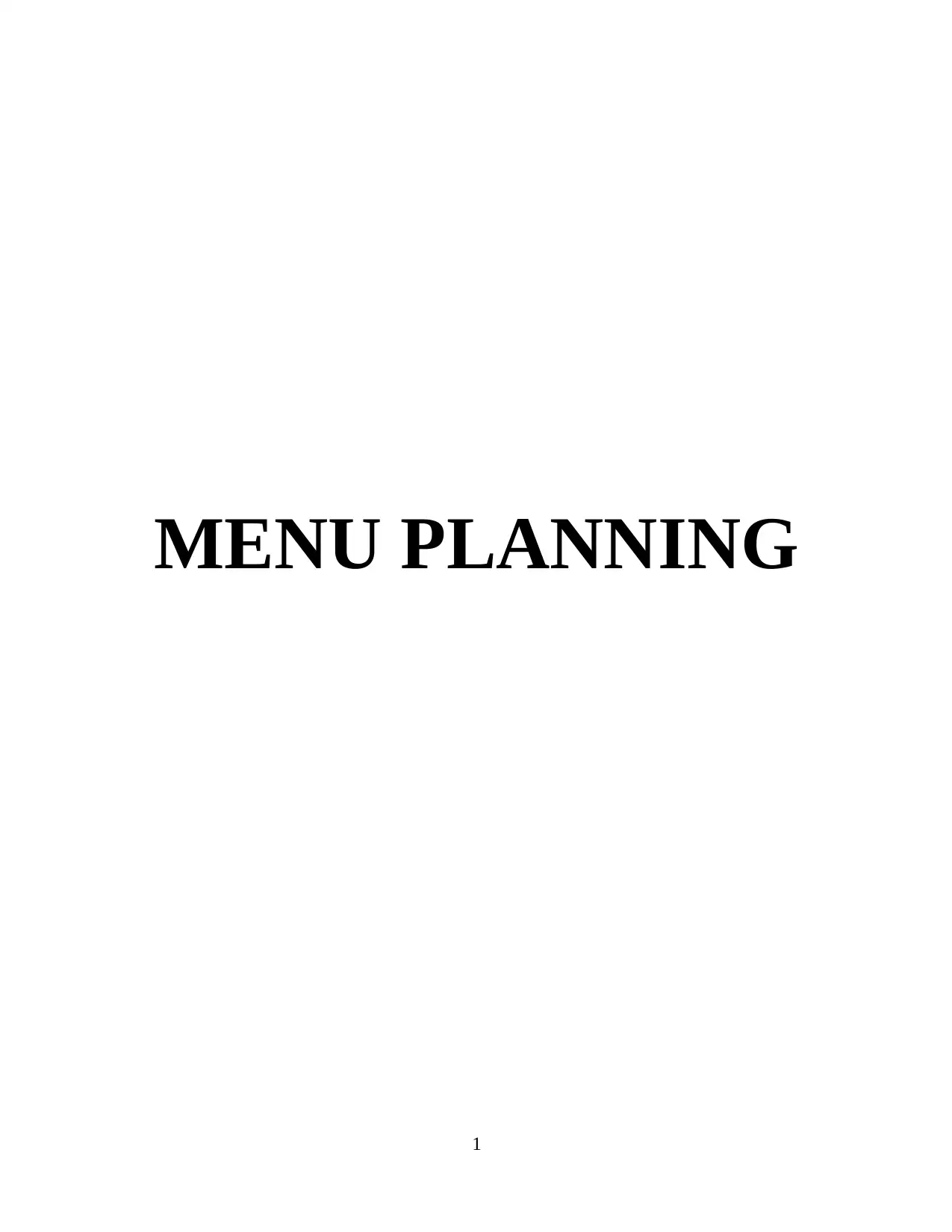
MENU PLANNING
1
1
Paraphrase This Document
Need a fresh take? Get an instant paraphrase of this document with our AI Paraphraser
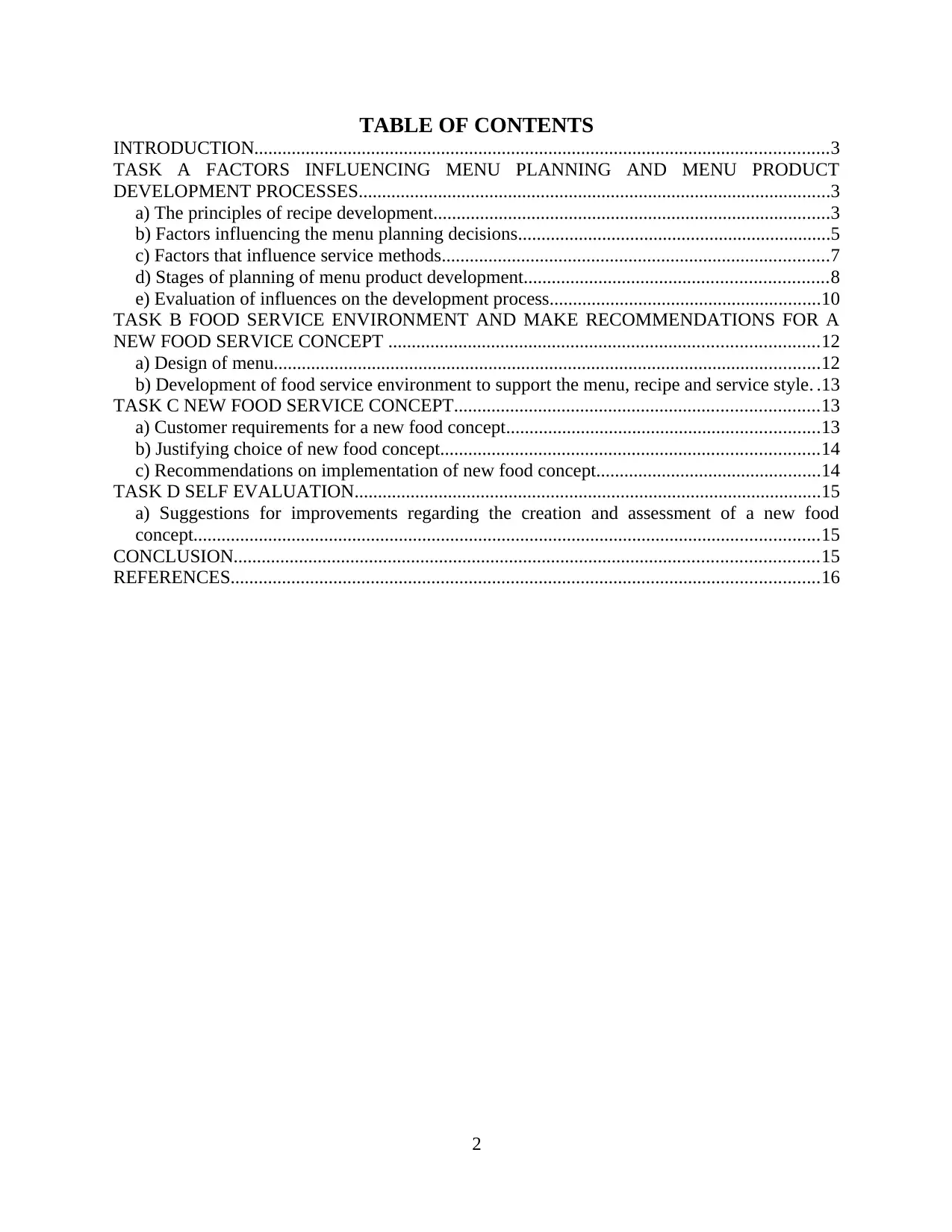
TABLE OF CONTENTS
INTRODUCTION...........................................................................................................................3
TASK A FACTORS INFLUENCING MENU PLANNING AND MENU PRODUCT
DEVELOPMENT PROCESSES.....................................................................................................3
a) The principles of recipe development.....................................................................................3
b) Factors influencing the menu planning decisions...................................................................5
c) Factors that influence service methods...................................................................................7
d) Stages of planning of menu product development.................................................................8
e) Evaluation of influences on the development process..........................................................10
TASK B FOOD SERVICE ENVIRONMENT AND MAKE RECOMMENDATIONS FOR A
NEW FOOD SERVICE CONCEPT ............................................................................................12
a) Design of menu.....................................................................................................................12
b) Development of food service environment to support the menu, recipe and service style. .13
TASK C NEW FOOD SERVICE CONCEPT..............................................................................13
a) Customer requirements for a new food concept...................................................................13
b) Justifying choice of new food concept.................................................................................14
c) Recommendations on implementation of new food concept................................................14
TASK D SELF EVALUATION....................................................................................................15
a) Suggestions for improvements regarding the creation and assessment of a new food
concept......................................................................................................................................15
CONCLUSION.............................................................................................................................15
REFERENCES..............................................................................................................................16
2
INTRODUCTION...........................................................................................................................3
TASK A FACTORS INFLUENCING MENU PLANNING AND MENU PRODUCT
DEVELOPMENT PROCESSES.....................................................................................................3
a) The principles of recipe development.....................................................................................3
b) Factors influencing the menu planning decisions...................................................................5
c) Factors that influence service methods...................................................................................7
d) Stages of planning of menu product development.................................................................8
e) Evaluation of influences on the development process..........................................................10
TASK B FOOD SERVICE ENVIRONMENT AND MAKE RECOMMENDATIONS FOR A
NEW FOOD SERVICE CONCEPT ............................................................................................12
a) Design of menu.....................................................................................................................12
b) Development of food service environment to support the menu, recipe and service style. .13
TASK C NEW FOOD SERVICE CONCEPT..............................................................................13
a) Customer requirements for a new food concept...................................................................13
b) Justifying choice of new food concept.................................................................................14
c) Recommendations on implementation of new food concept................................................14
TASK D SELF EVALUATION....................................................................................................15
a) Suggestions for improvements regarding the creation and assessment of a new food
concept......................................................................................................................................15
CONCLUSION.............................................................................................................................15
REFERENCES..............................................................................................................................16
2
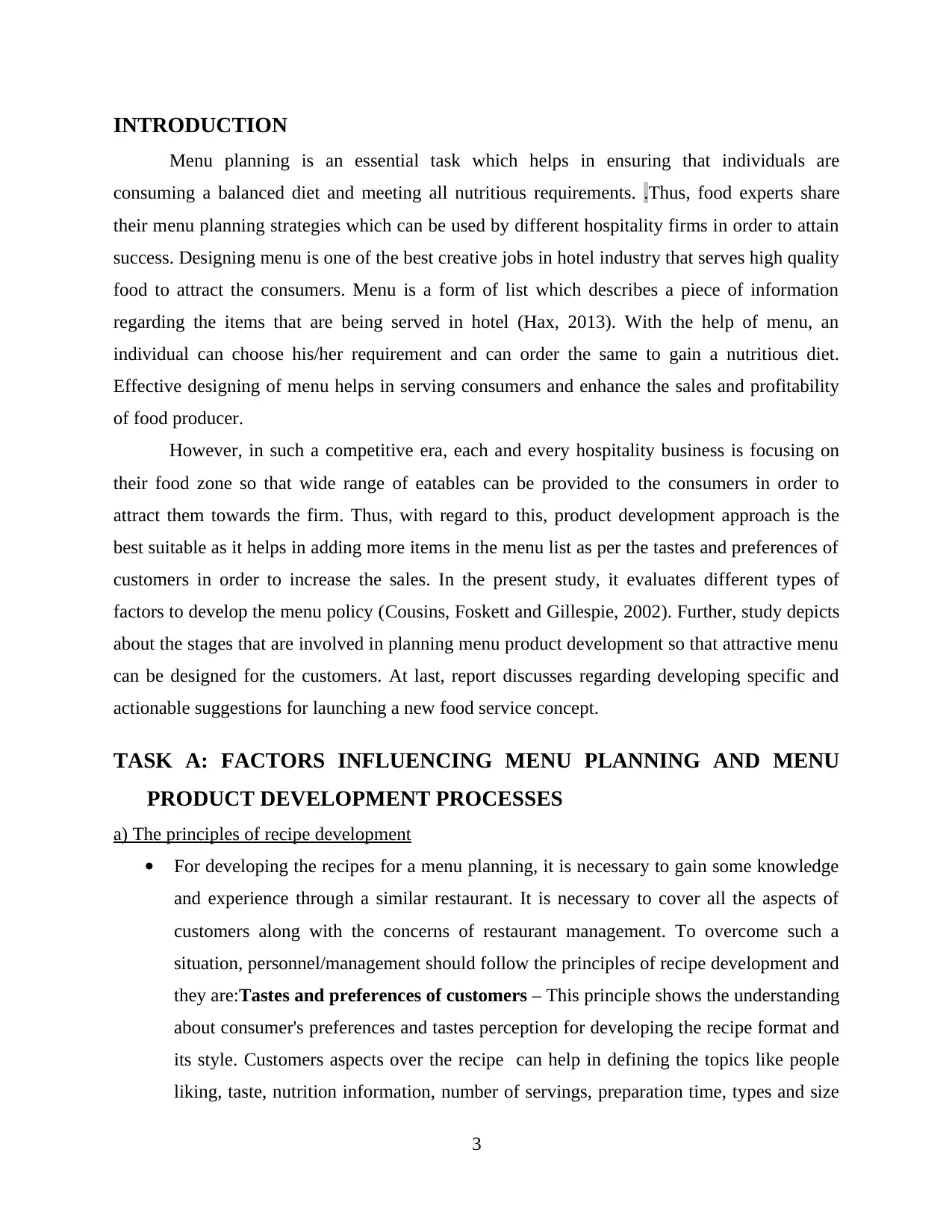
INTRODUCTION
Menu planning is an essential task which helps in ensuring that individuals are
consuming a balanced diet and meeting all nutritious requirements. .Thus, food experts share
their menu planning strategies which can be used by different hospitality firms in order to attain
success. Designing menu is one of the best creative jobs in hotel industry that serves high quality
food to attract the consumers. Menu is a form of list which describes a piece of information
regarding the items that are being served in hotel (Hax, 2013). With the help of menu, an
individual can choose his/her requirement and can order the same to gain a nutritious diet.
Effective designing of menu helps in serving consumers and enhance the sales and profitability
of food producer.
However, in such a competitive era, each and every hospitality business is focusing on
their food zone so that wide range of eatables can be provided to the consumers in order to
attract them towards the firm. Thus, with regard to this, product development approach is the
best suitable as it helps in adding more items in the menu list as per the tastes and preferences of
customers in order to increase the sales. In the present study, it evaluates different types of
factors to develop the menu policy (Cousins, Foskett and Gillespie, 2002). Further, study depicts
about the stages that are involved in planning menu product development so that attractive menu
can be designed for the customers. At last, report discusses regarding developing specific and
actionable suggestions for launching a new food service concept.
TASK A: FACTORS INFLUENCING MENU PLANNING AND MENU
PRODUCT DEVELOPMENT PROCESSES
a) The principles of recipe development
For developing the recipes for a menu planning, it is necessary to gain some knowledge
and experience through a similar restaurant. It is necessary to cover all the aspects of
customers along with the concerns of restaurant management. To overcome such a
situation, personnel/management should follow the principles of recipe development and
they are:Tastes and preferences of customers – This principle shows the understanding
about consumer's preferences and tastes perception for developing the recipe format and
its style. Customers aspects over the recipe can help in defining the topics like people
liking, taste, nutrition information, number of servings, preparation time, types and size
3
Menu planning is an essential task which helps in ensuring that individuals are
consuming a balanced diet and meeting all nutritious requirements. .Thus, food experts share
their menu planning strategies which can be used by different hospitality firms in order to attain
success. Designing menu is one of the best creative jobs in hotel industry that serves high quality
food to attract the consumers. Menu is a form of list which describes a piece of information
regarding the items that are being served in hotel (Hax, 2013). With the help of menu, an
individual can choose his/her requirement and can order the same to gain a nutritious diet.
Effective designing of menu helps in serving consumers and enhance the sales and profitability
of food producer.
However, in such a competitive era, each and every hospitality business is focusing on
their food zone so that wide range of eatables can be provided to the consumers in order to
attract them towards the firm. Thus, with regard to this, product development approach is the
best suitable as it helps in adding more items in the menu list as per the tastes and preferences of
customers in order to increase the sales. In the present study, it evaluates different types of
factors to develop the menu policy (Cousins, Foskett and Gillespie, 2002). Further, study depicts
about the stages that are involved in planning menu product development so that attractive menu
can be designed for the customers. At last, report discusses regarding developing specific and
actionable suggestions for launching a new food service concept.
TASK A: FACTORS INFLUENCING MENU PLANNING AND MENU
PRODUCT DEVELOPMENT PROCESSES
a) The principles of recipe development
For developing the recipes for a menu planning, it is necessary to gain some knowledge
and experience through a similar restaurant. It is necessary to cover all the aspects of
customers along with the concerns of restaurant management. To overcome such a
situation, personnel/management should follow the principles of recipe development and
they are:Tastes and preferences of customers – This principle shows the understanding
about consumer's preferences and tastes perception for developing the recipe format and
its style. Customers aspects over the recipe can help in defining the topics like people
liking, taste, nutrition information, number of servings, preparation time, types and size
3
⊘ This is a preview!⊘
Do you want full access?
Subscribe today to unlock all pages.

Trusted by 1+ million students worldwide
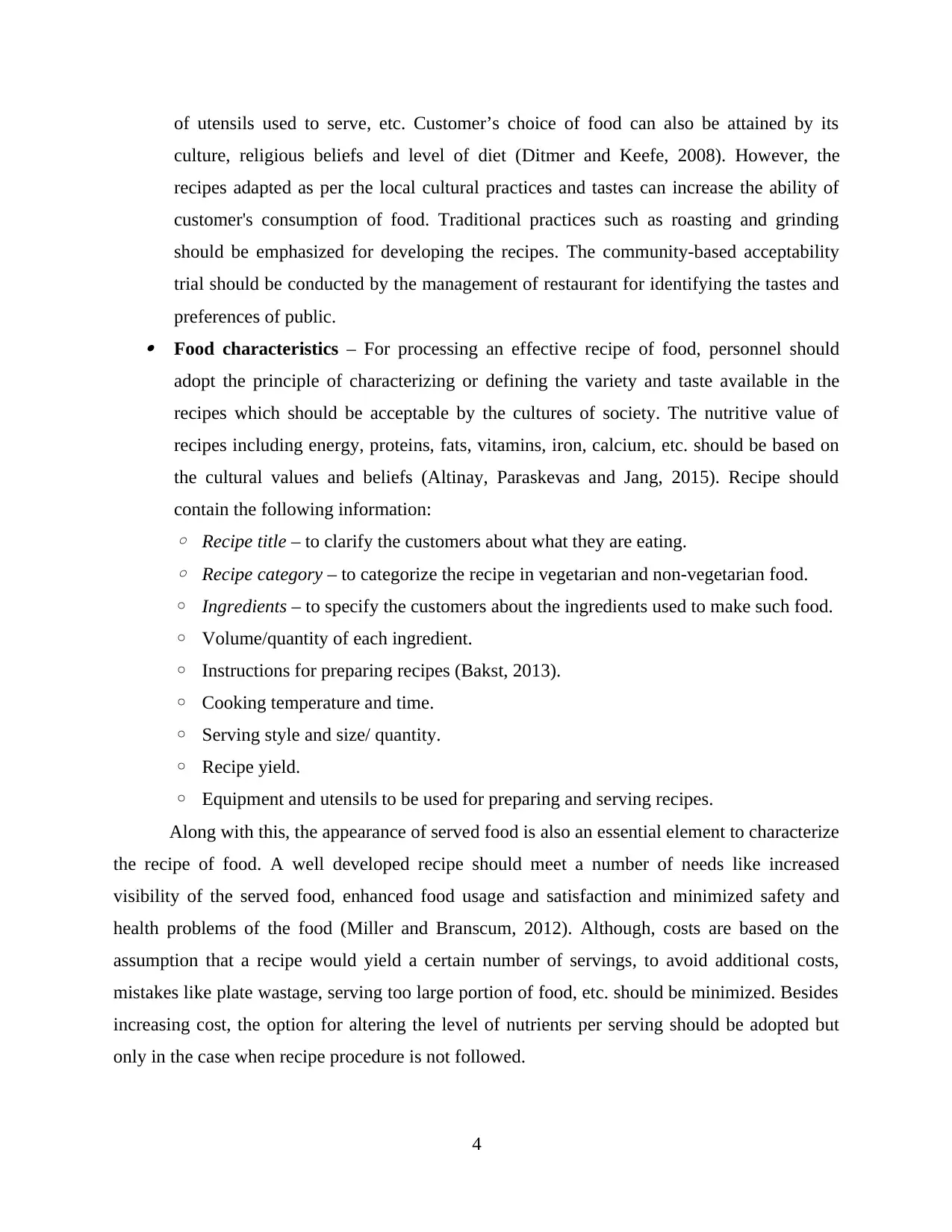
of utensils used to serve, etc. Customer’s choice of food can also be attained by its
culture, religious beliefs and level of diet (Ditmer and Keefe, 2008). However, the
recipes adapted as per the local cultural practices and tastes can increase the ability of
customer's consumption of food. Traditional practices such as roasting and grinding
should be emphasized for developing the recipes. The community-based acceptability
trial should be conducted by the management of restaurant for identifying the tastes and
preferences of public. Food characteristics – For processing an effective recipe of food, personnel should
adopt the principle of characterizing or defining the variety and taste available in the
recipes which should be acceptable by the cultures of society. The nutritive value of
recipes including energy, proteins, fats, vitamins, iron, calcium, etc. should be based on
the cultural values and beliefs (Altinay, Paraskevas and Jang, 2015). Recipe should
contain the following information:
◦ Recipe title – to clarify the customers about what they are eating.
◦ Recipe category – to categorize the recipe in vegetarian and non-vegetarian food.
◦ Ingredients – to specify the customers about the ingredients used to make such food.
◦ Volume/quantity of each ingredient.
◦ Instructions for preparing recipes (Bakst, 2013).
◦ Cooking temperature and time.
◦ Serving style and size/ quantity.
◦ Recipe yield.
◦ Equipment and utensils to be used for preparing and serving recipes.
Along with this, the appearance of served food is also an essential element to characterize
the recipe of food. A well developed recipe should meet a number of needs like increased
visibility of the served food, enhanced food usage and satisfaction and minimized safety and
health problems of the food (Miller and Branscum, 2012). Although, costs are based on the
assumption that a recipe would yield a certain number of servings, to avoid additional costs,
mistakes like plate wastage, serving too large portion of food, etc. should be minimized. Besides
increasing cost, the option for altering the level of nutrients per serving should be adopted but
only in the case when recipe procedure is not followed.
4
culture, religious beliefs and level of diet (Ditmer and Keefe, 2008). However, the
recipes adapted as per the local cultural practices and tastes can increase the ability of
customer's consumption of food. Traditional practices such as roasting and grinding
should be emphasized for developing the recipes. The community-based acceptability
trial should be conducted by the management of restaurant for identifying the tastes and
preferences of public. Food characteristics – For processing an effective recipe of food, personnel should
adopt the principle of characterizing or defining the variety and taste available in the
recipes which should be acceptable by the cultures of society. The nutritive value of
recipes including energy, proteins, fats, vitamins, iron, calcium, etc. should be based on
the cultural values and beliefs (Altinay, Paraskevas and Jang, 2015). Recipe should
contain the following information:
◦ Recipe title – to clarify the customers about what they are eating.
◦ Recipe category – to categorize the recipe in vegetarian and non-vegetarian food.
◦ Ingredients – to specify the customers about the ingredients used to make such food.
◦ Volume/quantity of each ingredient.
◦ Instructions for preparing recipes (Bakst, 2013).
◦ Cooking temperature and time.
◦ Serving style and size/ quantity.
◦ Recipe yield.
◦ Equipment and utensils to be used for preparing and serving recipes.
Along with this, the appearance of served food is also an essential element to characterize
the recipe of food. A well developed recipe should meet a number of needs like increased
visibility of the served food, enhanced food usage and satisfaction and minimized safety and
health problems of the food (Miller and Branscum, 2012). Although, costs are based on the
assumption that a recipe would yield a certain number of servings, to avoid additional costs,
mistakes like plate wastage, serving too large portion of food, etc. should be minimized. Besides
increasing cost, the option for altering the level of nutrients per serving should be adopted but
only in the case when recipe procedure is not followed.
4
Paraphrase This Document
Need a fresh take? Get an instant paraphrase of this document with our AI Paraphraser
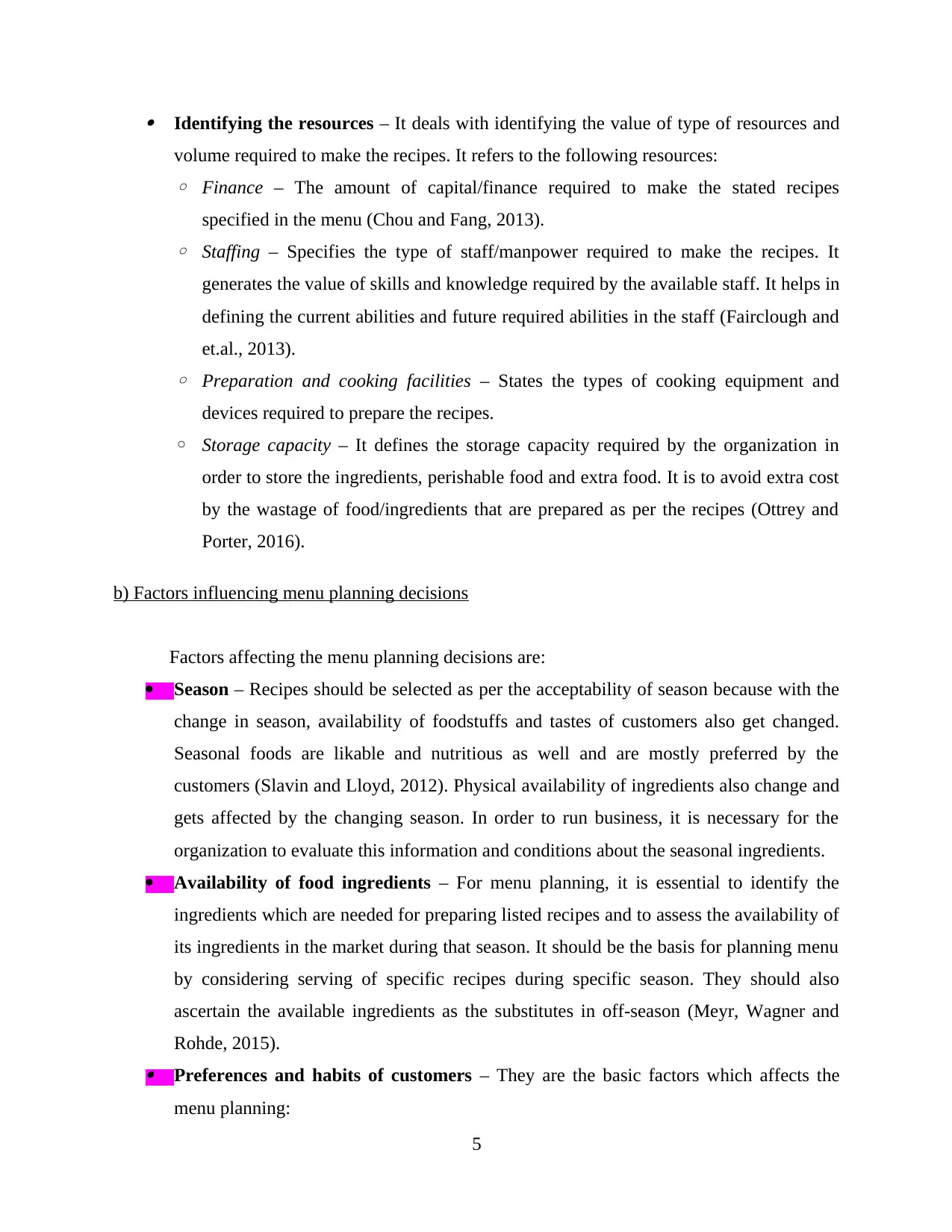
Identifying the resources – It deals with identifying the value of type of resources and
volume required to make the recipes. It refers to the following resources:
◦ Finance – The amount of capital/finance required to make the stated recipes
specified in the menu (Chou and Fang, 2013).
◦ Staffing – Specifies the type of staff/manpower required to make the recipes. It
generates the value of skills and knowledge required by the available staff. It helps in
defining the current abilities and future required abilities in the staff (Fairclough and
et.al., 2013).
◦ Preparation and cooking facilities – States the types of cooking equipment and
devices required to prepare the recipes.
◦ Storage capacity – It defines the storage capacity required by the organization in
order to store the ingredients, perishable food and extra food. It is to avoid extra cost
by the wastage of food/ingredients that are prepared as per the recipes (Ottrey and
Porter, 2016).
b) Factors influencing menu planning decisions
Factors affecting the menu planning decisions are:
Season – Recipes should be selected as per the acceptability of season because with the
change in season, availability of foodstuffs and tastes of customers also get changed.
Seasonal foods are likable and nutritious as well and are mostly preferred by the
customers (Slavin and Lloyd, 2012). Physical availability of ingredients also change and
gets affected by the changing season. In order to run business, it is necessary for the
organization to evaluate this information and conditions about the seasonal ingredients.
Availability of food ingredients – For menu planning, it is essential to identify the
ingredients which are needed for preparing listed recipes and to assess the availability of
its ingredients in the market during that season. It should be the basis for planning menu
by considering serving of specific recipes during specific season. They should also
ascertain the available ingredients as the substitutes in off-season (Meyr, Wagner and
Rohde, 2015). Preferences and habits of customers – They are the basic factors which affects the
menu planning:
5
volume required to make the recipes. It refers to the following resources:
◦ Finance – The amount of capital/finance required to make the stated recipes
specified in the menu (Chou and Fang, 2013).
◦ Staffing – Specifies the type of staff/manpower required to make the recipes. It
generates the value of skills and knowledge required by the available staff. It helps in
defining the current abilities and future required abilities in the staff (Fairclough and
et.al., 2013).
◦ Preparation and cooking facilities – States the types of cooking equipment and
devices required to prepare the recipes.
◦ Storage capacity – It defines the storage capacity required by the organization in
order to store the ingredients, perishable food and extra food. It is to avoid extra cost
by the wastage of food/ingredients that are prepared as per the recipes (Ottrey and
Porter, 2016).
b) Factors influencing menu planning decisions
Factors affecting the menu planning decisions are:
Season – Recipes should be selected as per the acceptability of season because with the
change in season, availability of foodstuffs and tastes of customers also get changed.
Seasonal foods are likable and nutritious as well and are mostly preferred by the
customers (Slavin and Lloyd, 2012). Physical availability of ingredients also change and
gets affected by the changing season. In order to run business, it is necessary for the
organization to evaluate this information and conditions about the seasonal ingredients.
Availability of food ingredients – For menu planning, it is essential to identify the
ingredients which are needed for preparing listed recipes and to assess the availability of
its ingredients in the market during that season. It should be the basis for planning menu
by considering serving of specific recipes during specific season. They should also
ascertain the available ingredients as the substitutes in off-season (Meyr, Wagner and
Rohde, 2015). Preferences and habits of customers – They are the basic factors which affects the
menu planning:
5
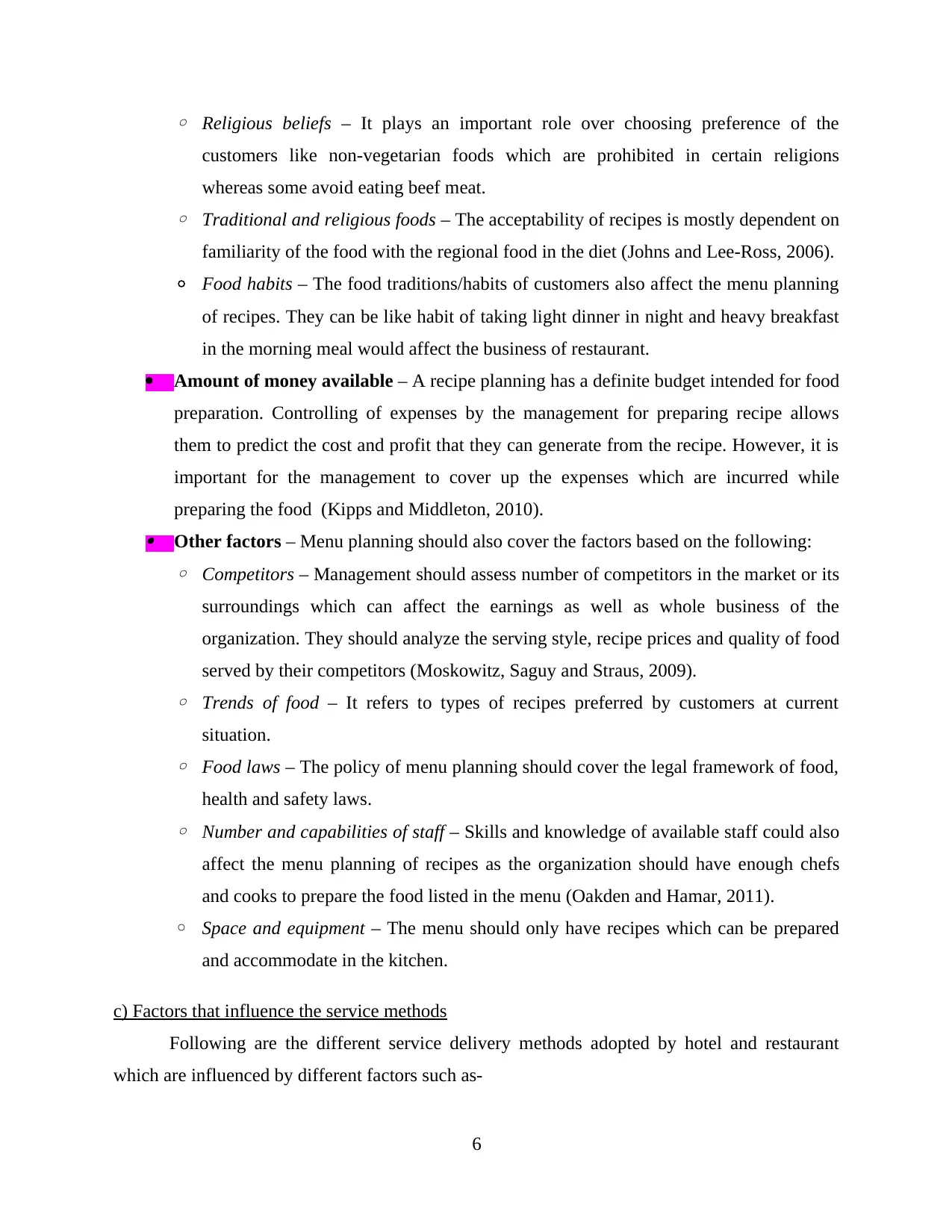
◦ Religious beliefs – It plays an important role over choosing preference of the
customers like non-vegetarian foods which are prohibited in certain religions
whereas some avoid eating beef meat.
◦ Traditional and religious foods – The acceptability of recipes is mostly dependent on
familiarity of the food with the regional food in the diet (Johns and Lee-Ross, 2006).
◦ Food habits – The food traditions/habits of customers also affect the menu planning
of recipes. They can be like habit of taking light dinner in night and heavy breakfast
in the morning meal would affect the business of restaurant.
Amount of money available – A recipe planning has a definite budget intended for food
preparation. Controlling of expenses by the management for preparing recipe allows
them to predict the cost and profit that they can generate from the recipe. However, it is
important for the management to cover up the expenses which are incurred while
preparing the food (Kipps and Middleton, 2010). Other factors – Menu planning should also cover the factors based on the following:
◦ Competitors – Management should assess number of competitors in the market or its
surroundings which can affect the earnings as well as whole business of the
organization. They should analyze the serving style, recipe prices and quality of food
served by their competitors (Moskowitz, Saguy and Straus, 2009).
◦ Trends of food – It refers to types of recipes preferred by customers at current
situation.
◦ Food laws – The policy of menu planning should cover the legal framework of food,
health and safety laws.
◦ Number and capabilities of staff – Skills and knowledge of available staff could also
affect the menu planning of recipes as the organization should have enough chefs
and cooks to prepare the food listed in the menu (Oakden and Hamar, 2011).
◦ Space and equipment – The menu should only have recipes which can be prepared
and accommodate in the kitchen.
c) Factors that influence the service methods
Following are the different service delivery methods adopted by hotel and restaurant
which are influenced by different factors such as-
6
customers like non-vegetarian foods which are prohibited in certain religions
whereas some avoid eating beef meat.
◦ Traditional and religious foods – The acceptability of recipes is mostly dependent on
familiarity of the food with the regional food in the diet (Johns and Lee-Ross, 2006).
◦ Food habits – The food traditions/habits of customers also affect the menu planning
of recipes. They can be like habit of taking light dinner in night and heavy breakfast
in the morning meal would affect the business of restaurant.
Amount of money available – A recipe planning has a definite budget intended for food
preparation. Controlling of expenses by the management for preparing recipe allows
them to predict the cost and profit that they can generate from the recipe. However, it is
important for the management to cover up the expenses which are incurred while
preparing the food (Kipps and Middleton, 2010). Other factors – Menu planning should also cover the factors based on the following:
◦ Competitors – Management should assess number of competitors in the market or its
surroundings which can affect the earnings as well as whole business of the
organization. They should analyze the serving style, recipe prices and quality of food
served by their competitors (Moskowitz, Saguy and Straus, 2009).
◦ Trends of food – It refers to types of recipes preferred by customers at current
situation.
◦ Food laws – The policy of menu planning should cover the legal framework of food,
health and safety laws.
◦ Number and capabilities of staff – Skills and knowledge of available staff could also
affect the menu planning of recipes as the organization should have enough chefs
and cooks to prepare the food listed in the menu (Oakden and Hamar, 2011).
◦ Space and equipment – The menu should only have recipes which can be prepared
and accommodate in the kitchen.
c) Factors that influence the service methods
Following are the different service delivery methods adopted by hotel and restaurant
which are influenced by different factors such as-
6
⊘ This is a preview!⊘
Do you want full access?
Subscribe today to unlock all pages.

Trusted by 1+ million students worldwide
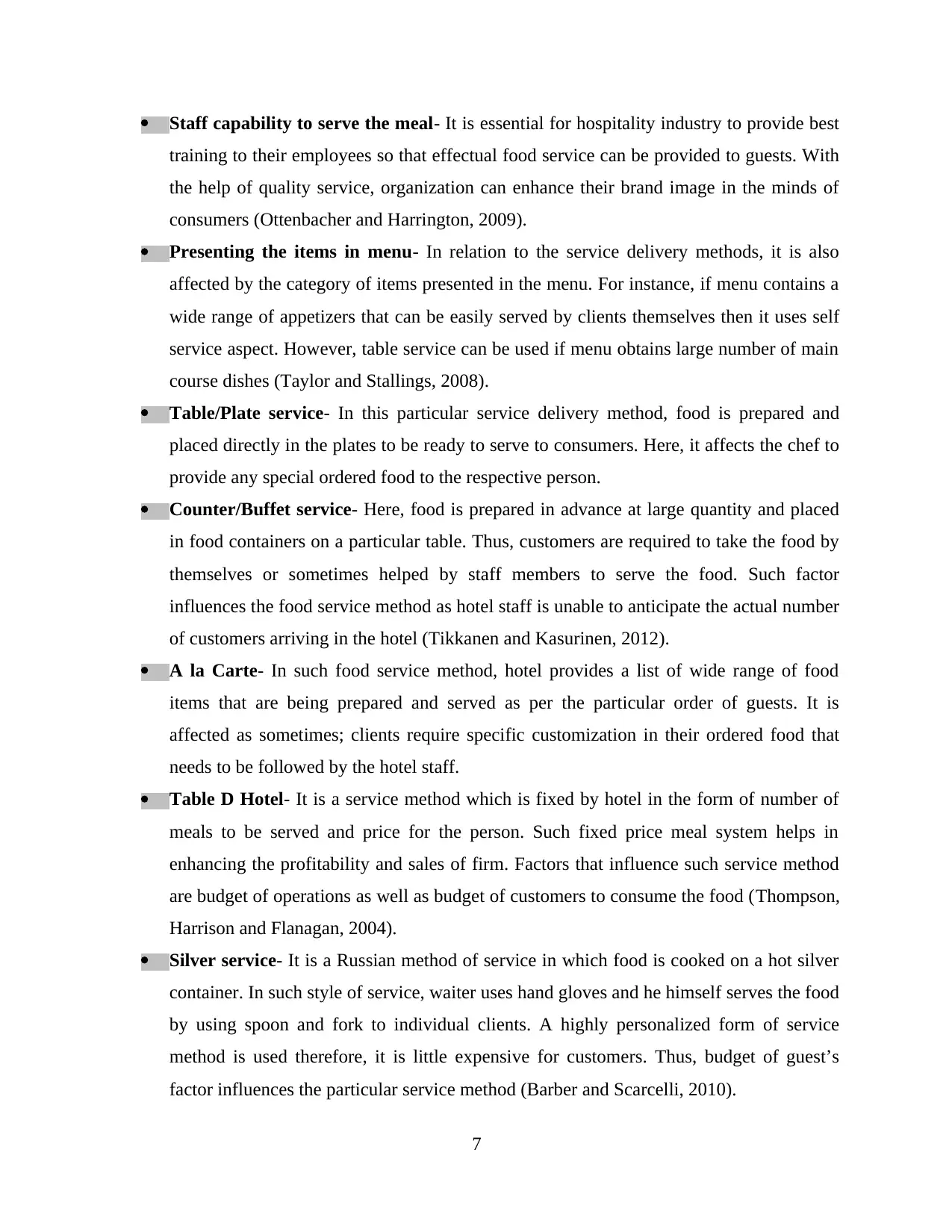
Staff capability to serve the meal- It is essential for hospitality industry to provide best
training to their employees so that effectual food service can be provided to guests. With
the help of quality service, organization can enhance their brand image in the minds of
consumers (Ottenbacher and Harrington, 2009).
Presenting the items in menu- In relation to the service delivery methods, it is also
affected by the category of items presented in the menu. For instance, if menu contains a
wide range of appetizers that can be easily served by clients themselves then it uses self
service aspect. However, table service can be used if menu obtains large number of main
course dishes (Taylor and Stallings, 2008).
Table/Plate service- In this particular service delivery method, food is prepared and
placed directly in the plates to be ready to serve to consumers. Here, it affects the chef to
provide any special ordered food to the respective person.
Counter/Buffet service- Here, food is prepared in advance at large quantity and placed
in food containers on a particular table. Thus, customers are required to take the food by
themselves or sometimes helped by staff members to serve the food. Such factor
influences the food service method as hotel staff is unable to anticipate the actual number
of customers arriving in the hotel (Tikkanen and Kasurinen, 2012).
A la Carte- In such food service method, hotel provides a list of wide range of food
items that are being prepared and served as per the particular order of guests. It is
affected as sometimes; clients require specific customization in their ordered food that
needs to be followed by the hotel staff.
Table D Hotel- It is a service method which is fixed by hotel in the form of number of
meals to be served and price for the person. Such fixed price meal system helps in
enhancing the profitability and sales of firm. Factors that influence such service method
are budget of operations as well as budget of customers to consume the food (Thompson,
Harrison and Flanagan, 2004).
Silver service- It is a Russian method of service in which food is cooked on a hot silver
container. In such style of service, waiter uses hand gloves and he himself serves the food
by using spoon and fork to individual clients. A highly personalized form of service
method is used therefore, it is little expensive for customers. Thus, budget of guest’s
factor influences the particular service method (Barber and Scarcelli, 2010).
7
training to their employees so that effectual food service can be provided to guests. With
the help of quality service, organization can enhance their brand image in the minds of
consumers (Ottenbacher and Harrington, 2009).
Presenting the items in menu- In relation to the service delivery methods, it is also
affected by the category of items presented in the menu. For instance, if menu contains a
wide range of appetizers that can be easily served by clients themselves then it uses self
service aspect. However, table service can be used if menu obtains large number of main
course dishes (Taylor and Stallings, 2008).
Table/Plate service- In this particular service delivery method, food is prepared and
placed directly in the plates to be ready to serve to consumers. Here, it affects the chef to
provide any special ordered food to the respective person.
Counter/Buffet service- Here, food is prepared in advance at large quantity and placed
in food containers on a particular table. Thus, customers are required to take the food by
themselves or sometimes helped by staff members to serve the food. Such factor
influences the food service method as hotel staff is unable to anticipate the actual number
of customers arriving in the hotel (Tikkanen and Kasurinen, 2012).
A la Carte- In such food service method, hotel provides a list of wide range of food
items that are being prepared and served as per the particular order of guests. It is
affected as sometimes; clients require specific customization in their ordered food that
needs to be followed by the hotel staff.
Table D Hotel- It is a service method which is fixed by hotel in the form of number of
meals to be served and price for the person. Such fixed price meal system helps in
enhancing the profitability and sales of firm. Factors that influence such service method
are budget of operations as well as budget of customers to consume the food (Thompson,
Harrison and Flanagan, 2004).
Silver service- It is a Russian method of service in which food is cooked on a hot silver
container. In such style of service, waiter uses hand gloves and he himself serves the food
by using spoon and fork to individual clients. A highly personalized form of service
method is used therefore, it is little expensive for customers. Thus, budget of guest’s
factor influences the particular service method (Barber and Scarcelli, 2010).
7
Paraphrase This Document
Need a fresh take? Get an instant paraphrase of this document with our AI Paraphraser
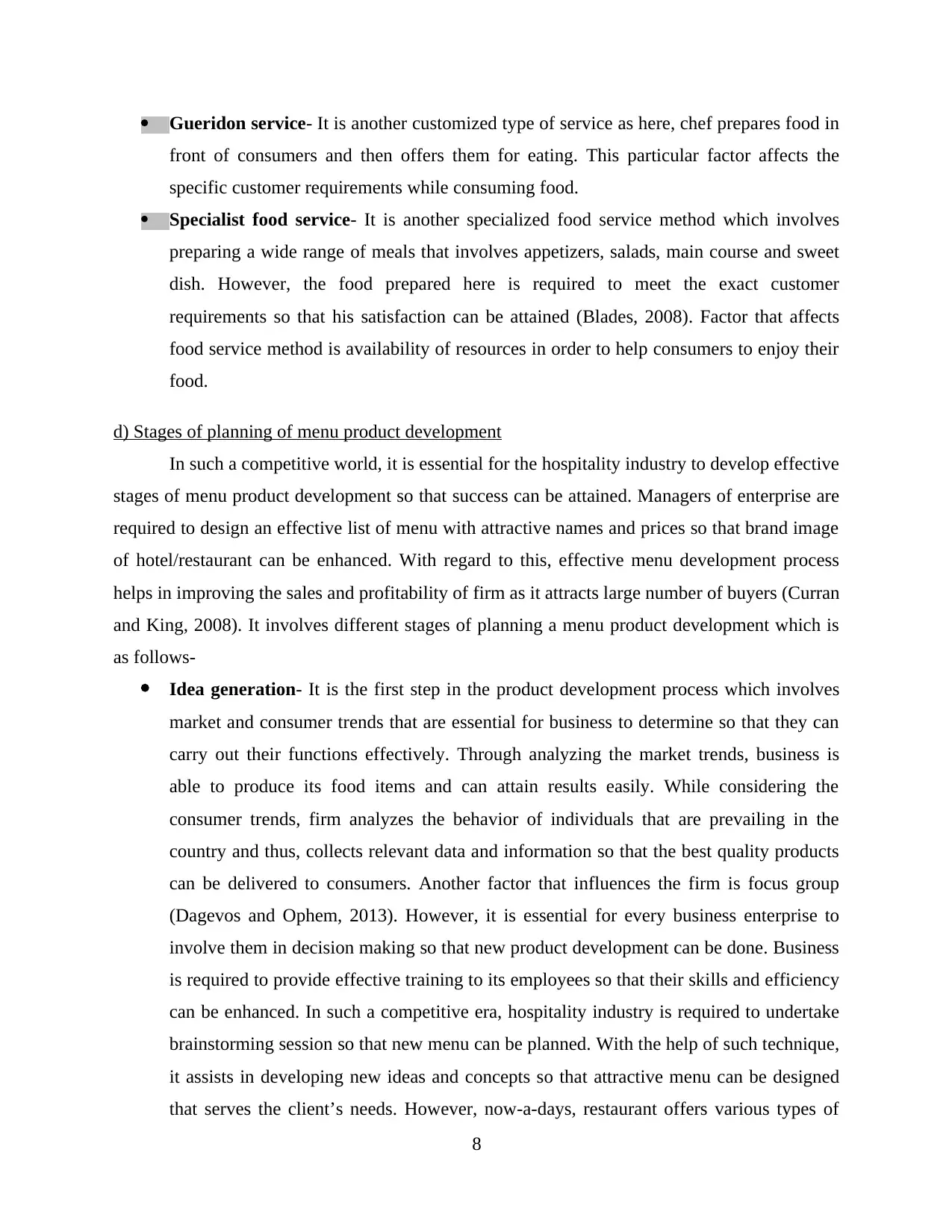
Gueridon service- It is another customized type of service as here, chef prepares food in
front of consumers and then offers them for eating. This particular factor affects the
specific customer requirements while consuming food.
Specialist food service- It is another specialized food service method which involves
preparing a wide range of meals that involves appetizers, salads, main course and sweet
dish. However, the food prepared here is required to meet the exact customer
requirements so that his satisfaction can be attained (Blades, 2008). Factor that affects
food service method is availability of resources in order to help consumers to enjoy their
food.
d) Stages of planning of menu product development
In such a competitive world, it is essential for the hospitality industry to develop effective
stages of menu product development so that success can be attained. Managers of enterprise are
required to design an effective list of menu with attractive names and prices so that brand image
of hotel/restaurant can be enhanced. With regard to this, effective menu development process
helps in improving the sales and profitability of firm as it attracts large number of buyers (Curran
and King, 2008). It involves different stages of planning a menu product development which is
as follows-
Idea generation- It is the first step in the product development process which involves
market and consumer trends that are essential for business to determine so that they can
carry out their functions effectively. Through analyzing the market trends, business is
able to produce its food items and can attain results easily. While considering the
consumer trends, firm analyzes the behavior of individuals that are prevailing in the
country and thus, collects relevant data and information so that the best quality products
can be delivered to consumers. Another factor that influences the firm is focus group
(Dagevos and Ophem, 2013). However, it is essential for every business enterprise to
involve them in decision making so that new product development can be done. Business
is required to provide effective training to its employees so that their skills and efficiency
can be enhanced. In such a competitive era, hospitality industry is required to undertake
brainstorming session so that new menu can be planned. With the help of such technique,
it assists in developing new ideas and concepts so that attractive menu can be designed
that serves the client’s needs. However, now-a-days, restaurant offers various types of
8
front of consumers and then offers them for eating. This particular factor affects the
specific customer requirements while consuming food.
Specialist food service- It is another specialized food service method which involves
preparing a wide range of meals that involves appetizers, salads, main course and sweet
dish. However, the food prepared here is required to meet the exact customer
requirements so that his satisfaction can be attained (Blades, 2008). Factor that affects
food service method is availability of resources in order to help consumers to enjoy their
food.
d) Stages of planning of menu product development
In such a competitive world, it is essential for the hospitality industry to develop effective
stages of menu product development so that success can be attained. Managers of enterprise are
required to design an effective list of menu with attractive names and prices so that brand image
of hotel/restaurant can be enhanced. With regard to this, effective menu development process
helps in improving the sales and profitability of firm as it attracts large number of buyers (Curran
and King, 2008). It involves different stages of planning a menu product development which is
as follows-
Idea generation- It is the first step in the product development process which involves
market and consumer trends that are essential for business to determine so that they can
carry out their functions effectively. Through analyzing the market trends, business is
able to produce its food items and can attain results easily. While considering the
consumer trends, firm analyzes the behavior of individuals that are prevailing in the
country and thus, collects relevant data and information so that the best quality products
can be delivered to consumers. Another factor that influences the firm is focus group
(Dagevos and Ophem, 2013). However, it is essential for every business enterprise to
involve them in decision making so that new product development can be done. Business
is required to provide effective training to its employees so that their skills and efficiency
can be enhanced. In such a competitive era, hospitality industry is required to undertake
brainstorming session so that new menu can be planned. With the help of such technique,
it assists in developing new ideas and concepts so that attractive menu can be designed
that serves the client’s needs. However, now-a-days, restaurant offers various types of
8
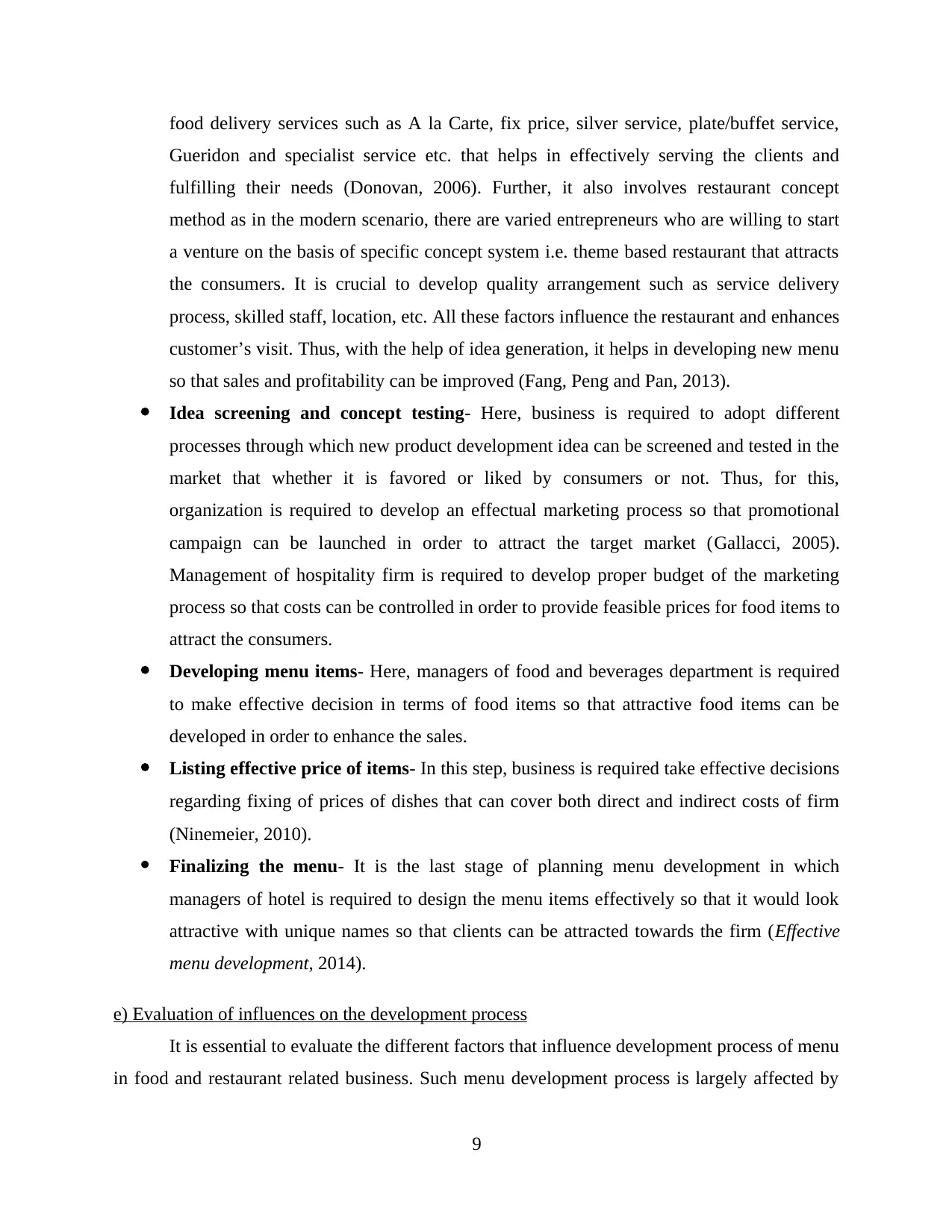
food delivery services such as A la Carte, fix price, silver service, plate/buffet service,
Gueridon and specialist service etc. that helps in effectively serving the clients and
fulfilling their needs (Donovan, 2006). Further, it also involves restaurant concept
method as in the modern scenario, there are varied entrepreneurs who are willing to start
a venture on the basis of specific concept system i.e. theme based restaurant that attracts
the consumers. It is crucial to develop quality arrangement such as service delivery
process, skilled staff, location, etc. All these factors influence the restaurant and enhances
customer’s visit. Thus, with the help of idea generation, it helps in developing new menu
so that sales and profitability can be improved (Fang, Peng and Pan, 2013).
Idea screening and concept testing- Here, business is required to adopt different
processes through which new product development idea can be screened and tested in the
market that whether it is favored or liked by consumers or not. Thus, for this,
organization is required to develop an effectual marketing process so that promotional
campaign can be launched in order to attract the target market (Gallacci, 2005).
Management of hospitality firm is required to develop proper budget of the marketing
process so that costs can be controlled in order to provide feasible prices for food items to
attract the consumers.
Developing menu items- Here, managers of food and beverages department is required
to make effective decision in terms of food items so that attractive food items can be
developed in order to enhance the sales.
Listing effective price of items- In this step, business is required take effective decisions
regarding fixing of prices of dishes that can cover both direct and indirect costs of firm
(Ninemeier, 2010).
Finalizing the menu- It is the last stage of planning menu development in which
managers of hotel is required to design the menu items effectively so that it would look
attractive with unique names so that clients can be attracted towards the firm (Effective
menu development, 2014).
e) Evaluation of influences on the development process
It is essential to evaluate the different factors that influence development process of menu
in food and restaurant related business. Such menu development process is largely affected by
9
Gueridon and specialist service etc. that helps in effectively serving the clients and
fulfilling their needs (Donovan, 2006). Further, it also involves restaurant concept
method as in the modern scenario, there are varied entrepreneurs who are willing to start
a venture on the basis of specific concept system i.e. theme based restaurant that attracts
the consumers. It is crucial to develop quality arrangement such as service delivery
process, skilled staff, location, etc. All these factors influence the restaurant and enhances
customer’s visit. Thus, with the help of idea generation, it helps in developing new menu
so that sales and profitability can be improved (Fang, Peng and Pan, 2013).
Idea screening and concept testing- Here, business is required to adopt different
processes through which new product development idea can be screened and tested in the
market that whether it is favored or liked by consumers or not. Thus, for this,
organization is required to develop an effectual marketing process so that promotional
campaign can be launched in order to attract the target market (Gallacci, 2005).
Management of hospitality firm is required to develop proper budget of the marketing
process so that costs can be controlled in order to provide feasible prices for food items to
attract the consumers.
Developing menu items- Here, managers of food and beverages department is required
to make effective decision in terms of food items so that attractive food items can be
developed in order to enhance the sales.
Listing effective price of items- In this step, business is required take effective decisions
regarding fixing of prices of dishes that can cover both direct and indirect costs of firm
(Ninemeier, 2010).
Finalizing the menu- It is the last stage of planning menu development in which
managers of hotel is required to design the menu items effectively so that it would look
attractive with unique names so that clients can be attracted towards the firm (Effective
menu development, 2014).
e) Evaluation of influences on the development process
It is essential to evaluate the different factors that influence development process of menu
in food and restaurant related business. Such menu development process is largely affected by
9
⊘ This is a preview!⊘
Do you want full access?
Subscribe today to unlock all pages.

Trusted by 1+ million students worldwide
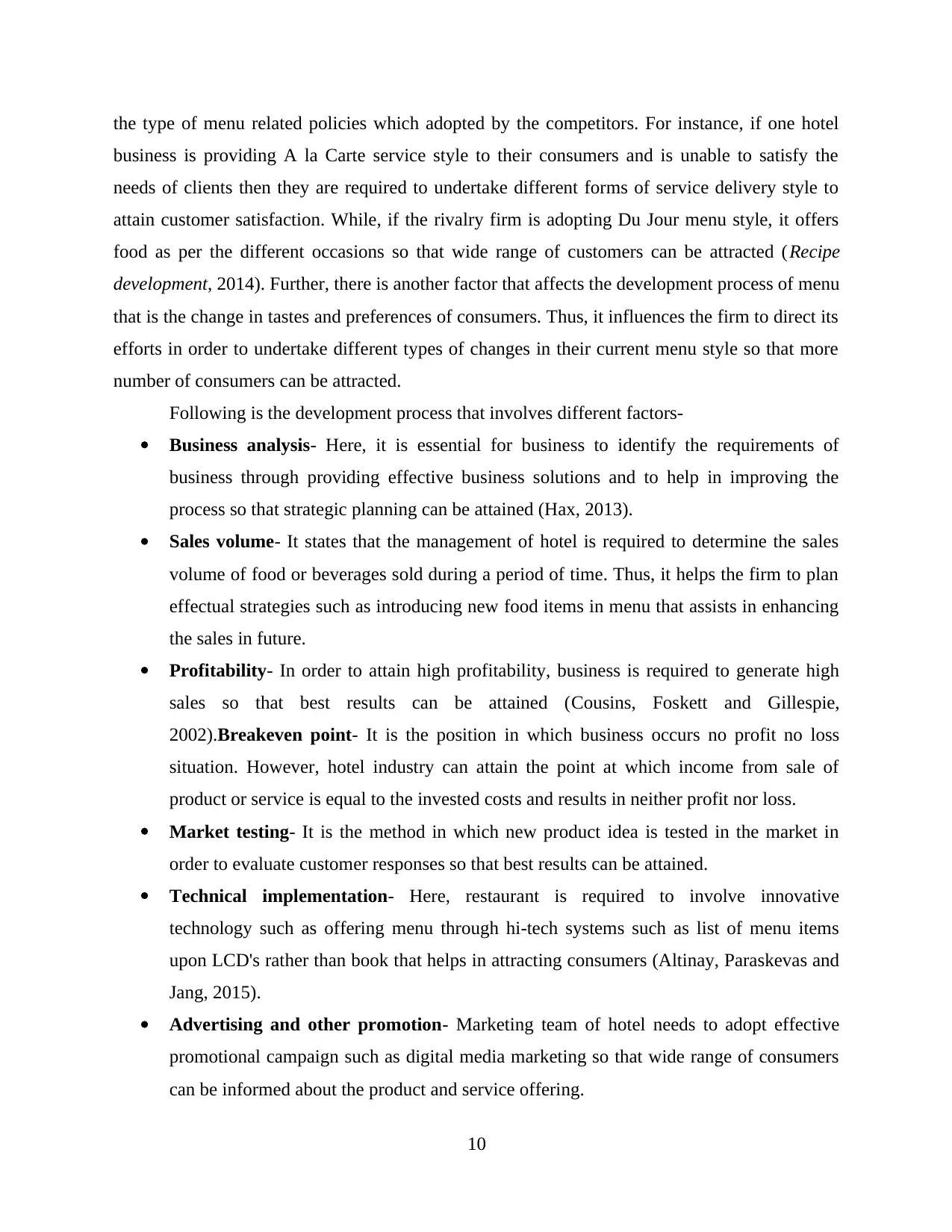
the type of menu related policies which adopted by the competitors. For instance, if one hotel
business is providing A la Carte service style to their consumers and is unable to satisfy the
needs of clients then they are required to undertake different forms of service delivery style to
attain customer satisfaction. While, if the rivalry firm is adopting Du Jour menu style, it offers
food as per the different occasions so that wide range of customers can be attracted (Recipe
development, 2014). Further, there is another factor that affects the development process of menu
that is the change in tastes and preferences of consumers. Thus, it influences the firm to direct its
efforts in order to undertake different types of changes in their current menu style so that more
number of consumers can be attracted.
Following is the development process that involves different factors-
Business analysis- Here, it is essential for business to identify the requirements of
business through providing effective business solutions and to help in improving the
process so that strategic planning can be attained (Hax, 2013).
Sales volume- It states that the management of hotel is required to determine the sales
volume of food or beverages sold during a period of time. Thus, it helps the firm to plan
effectual strategies such as introducing new food items in menu that assists in enhancing
the sales in future.
Profitability- In order to attain high profitability, business is required to generate high
sales so that best results can be attained (Cousins, Foskett and Gillespie,
2002).Breakeven point- It is the position in which business occurs no profit no loss
situation. However, hotel industry can attain the point at which income from sale of
product or service is equal to the invested costs and results in neither profit nor loss.
Market testing- It is the method in which new product idea is tested in the market in
order to evaluate customer responses so that best results can be attained.
Technical implementation- Here, restaurant is required to involve innovative
technology such as offering menu through hi-tech systems such as list of menu items
upon LCD's rather than book that helps in attracting consumers (Altinay, Paraskevas and
Jang, 2015).
Advertising and other promotion- Marketing team of hotel needs to adopt effective
promotional campaign such as digital media marketing so that wide range of consumers
can be informed about the product and service offering.
10
business is providing A la Carte service style to their consumers and is unable to satisfy the
needs of clients then they are required to undertake different forms of service delivery style to
attain customer satisfaction. While, if the rivalry firm is adopting Du Jour menu style, it offers
food as per the different occasions so that wide range of customers can be attracted (Recipe
development, 2014). Further, there is another factor that affects the development process of menu
that is the change in tastes and preferences of consumers. Thus, it influences the firm to direct its
efforts in order to undertake different types of changes in their current menu style so that more
number of consumers can be attracted.
Following is the development process that involves different factors-
Business analysis- Here, it is essential for business to identify the requirements of
business through providing effective business solutions and to help in improving the
process so that strategic planning can be attained (Hax, 2013).
Sales volume- It states that the management of hotel is required to determine the sales
volume of food or beverages sold during a period of time. Thus, it helps the firm to plan
effectual strategies such as introducing new food items in menu that assists in enhancing
the sales in future.
Profitability- In order to attain high profitability, business is required to generate high
sales so that best results can be attained (Cousins, Foskett and Gillespie,
2002).Breakeven point- It is the position in which business occurs no profit no loss
situation. However, hotel industry can attain the point at which income from sale of
product or service is equal to the invested costs and results in neither profit nor loss.
Market testing- It is the method in which new product idea is tested in the market in
order to evaluate customer responses so that best results can be attained.
Technical implementation- Here, restaurant is required to involve innovative
technology such as offering menu through hi-tech systems such as list of menu items
upon LCD's rather than book that helps in attracting consumers (Altinay, Paraskevas and
Jang, 2015).
Advertising and other promotion- Marketing team of hotel needs to adopt effective
promotional campaign such as digital media marketing so that wide range of consumers
can be informed about the product and service offering.
10
Paraphrase This Document
Need a fresh take? Get an instant paraphrase of this document with our AI Paraphraser
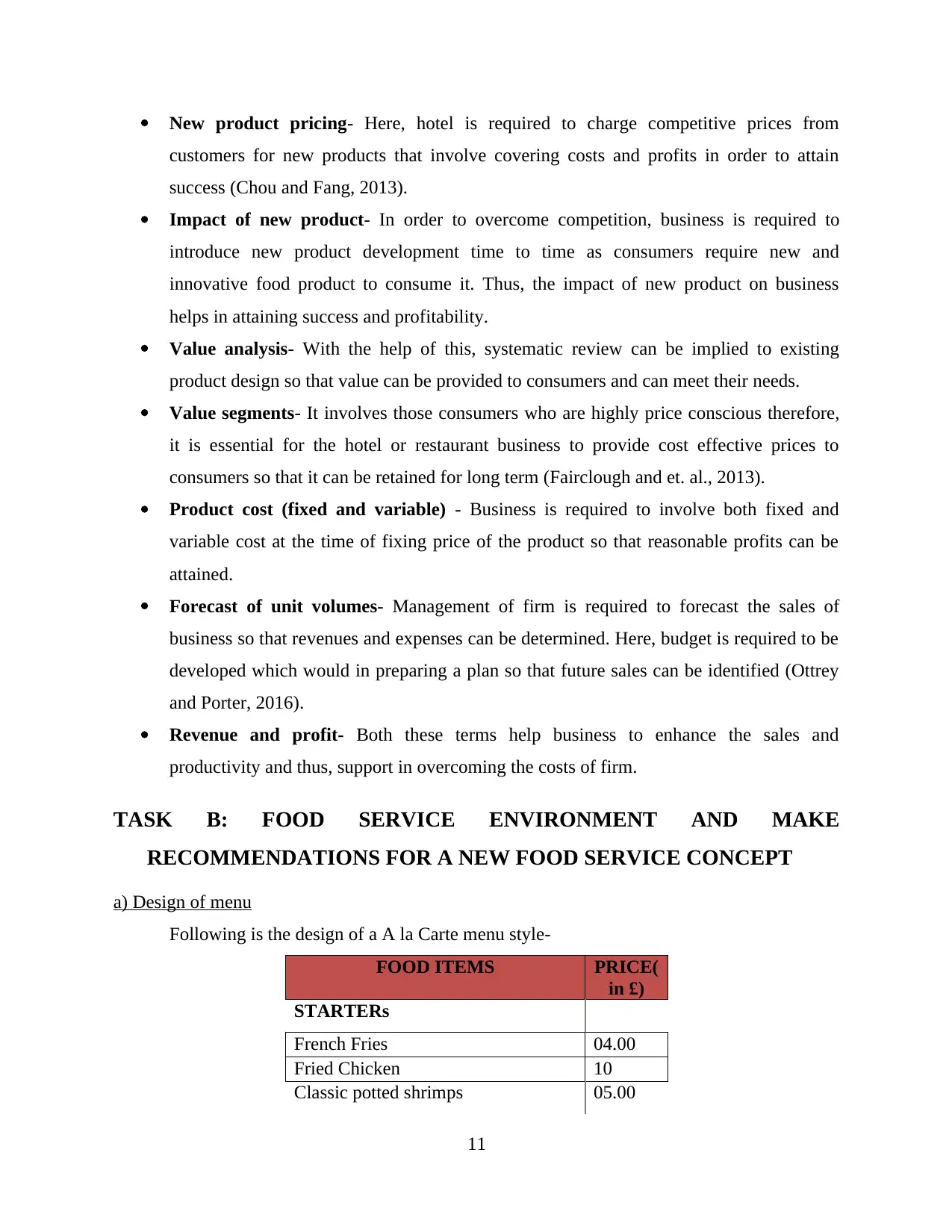
New product pricing- Here, hotel is required to charge competitive prices from
customers for new products that involve covering costs and profits in order to attain
success (Chou and Fang, 2013).
Impact of new product- In order to overcome competition, business is required to
introduce new product development time to time as consumers require new and
innovative food product to consume it. Thus, the impact of new product on business
helps in attaining success and profitability.
Value analysis- With the help of this, systematic review can be implied to existing
product design so that value can be provided to consumers and can meet their needs.
Value segments- It involves those consumers who are highly price conscious therefore,
it is essential for the hotel or restaurant business to provide cost effective prices to
consumers so that it can be retained for long term (Fairclough and et. al., 2013).
Product cost (fixed and variable) - Business is required to involve both fixed and
variable cost at the time of fixing price of the product so that reasonable profits can be
attained.
Forecast of unit volumes- Management of firm is required to forecast the sales of
business so that revenues and expenses can be determined. Here, budget is required to be
developed which would in preparing a plan so that future sales can be identified (Ottrey
and Porter, 2016).
Revenue and profit- Both these terms help business to enhance the sales and
productivity and thus, support in overcoming the costs of firm.
TASK B: FOOD SERVICE ENVIRONMENT AND MAKE
RECOMMENDATIONS FOR A NEW FOOD SERVICE CONCEPT
a) Design of menu
Following is the design of a A la Carte menu style-
FOOD ITEMS PRICE(
in £)
STARTERs
French Fries 04.00
Fried Chicken 10
Classic potted shrimps 05.00
11
customers for new products that involve covering costs and profits in order to attain
success (Chou and Fang, 2013).
Impact of new product- In order to overcome competition, business is required to
introduce new product development time to time as consumers require new and
innovative food product to consume it. Thus, the impact of new product on business
helps in attaining success and profitability.
Value analysis- With the help of this, systematic review can be implied to existing
product design so that value can be provided to consumers and can meet their needs.
Value segments- It involves those consumers who are highly price conscious therefore,
it is essential for the hotel or restaurant business to provide cost effective prices to
consumers so that it can be retained for long term (Fairclough and et. al., 2013).
Product cost (fixed and variable) - Business is required to involve both fixed and
variable cost at the time of fixing price of the product so that reasonable profits can be
attained.
Forecast of unit volumes- Management of firm is required to forecast the sales of
business so that revenues and expenses can be determined. Here, budget is required to be
developed which would in preparing a plan so that future sales can be identified (Ottrey
and Porter, 2016).
Revenue and profit- Both these terms help business to enhance the sales and
productivity and thus, support in overcoming the costs of firm.
TASK B: FOOD SERVICE ENVIRONMENT AND MAKE
RECOMMENDATIONS FOR A NEW FOOD SERVICE CONCEPT
a) Design of menu
Following is the design of a A la Carte menu style-
FOOD ITEMS PRICE(
in £)
STARTERs
French Fries 04.00
Fried Chicken 10
Classic potted shrimps 05.00
11
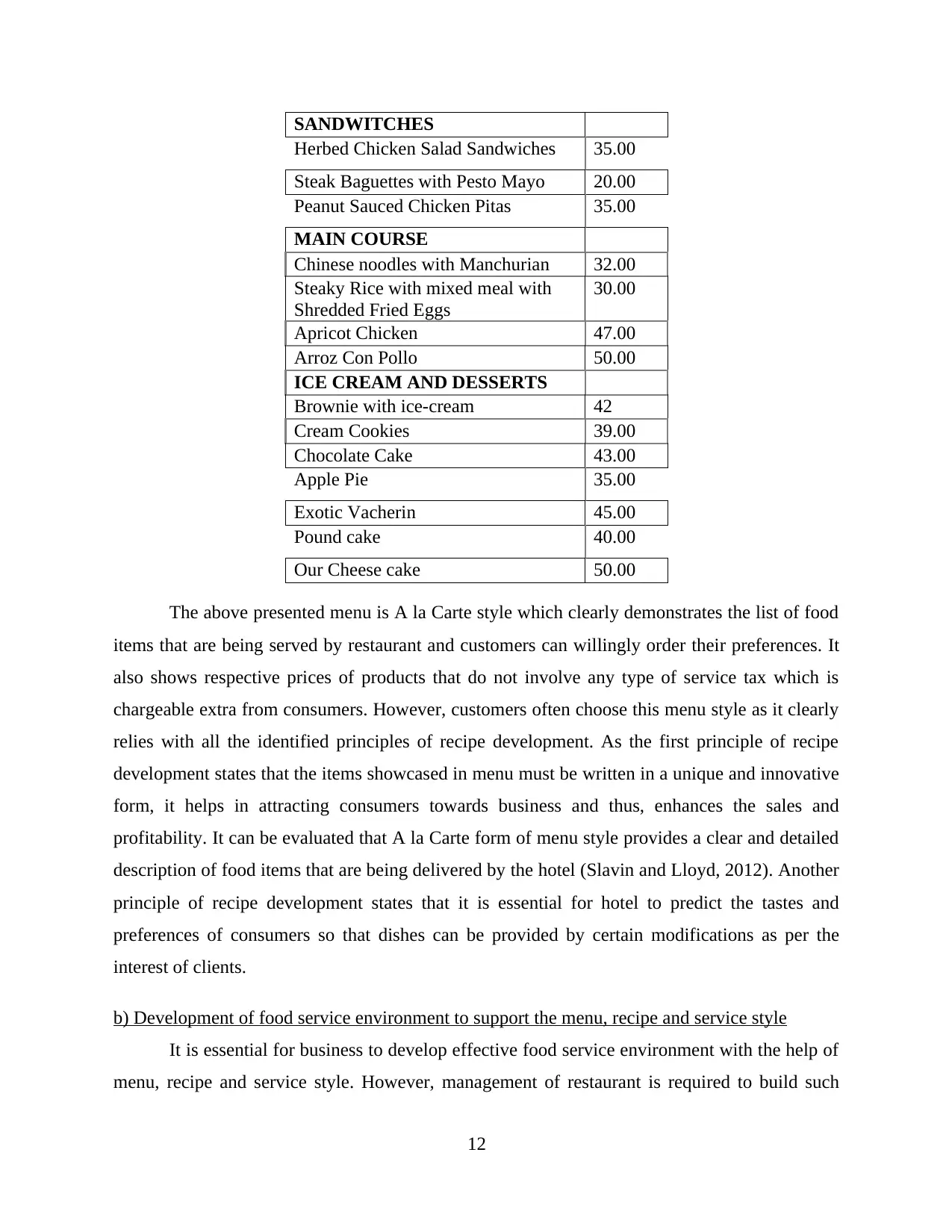
SANDWITCHES
Herbed Chicken Salad Sandwiches 35.00
Steak Baguettes with Pesto Mayo 20.00
Peanut Sauced Chicken Pitas 35.00
MAIN COURSE
Chinese noodles with Manchurian 32.00
Steaky Rice with mixed meal with
Shredded Fried Eggs
30.00
Apricot Chicken 47.00
Arroz Con Pollo 50.00
ICE CREAM AND DESSERTS
Brownie with ice-cream 42
Cream Cookies 39.00
Chocolate Cake 43.00
Apple Pie 35.00
Exotic Vacherin 45.00
Pound cake 40.00
Our Cheese cake 50.00
The above presented menu is A la Carte style which clearly demonstrates the list of food
items that are being served by restaurant and customers can willingly order their preferences. It
also shows respective prices of products that do not involve any type of service tax which is
chargeable extra from consumers. However, customers often choose this menu style as it clearly
relies with all the identified principles of recipe development. As the first principle of recipe
development states that the items showcased in menu must be written in a unique and innovative
form, it helps in attracting consumers towards business and thus, enhances the sales and
profitability. It can be evaluated that A la Carte form of menu style provides a clear and detailed
description of food items that are being delivered by the hotel (Slavin and Lloyd, 2012). Another
principle of recipe development states that it is essential for hotel to predict the tastes and
preferences of consumers so that dishes can be provided by certain modifications as per the
interest of clients.
b) Development of food service environment to support the menu, recipe and service style
It is essential for business to develop effective food service environment with the help of
menu, recipe and service style. However, management of restaurant is required to build such
12
Herbed Chicken Salad Sandwiches 35.00
Steak Baguettes with Pesto Mayo 20.00
Peanut Sauced Chicken Pitas 35.00
MAIN COURSE
Chinese noodles with Manchurian 32.00
Steaky Rice with mixed meal with
Shredded Fried Eggs
30.00
Apricot Chicken 47.00
Arroz Con Pollo 50.00
ICE CREAM AND DESSERTS
Brownie with ice-cream 42
Cream Cookies 39.00
Chocolate Cake 43.00
Apple Pie 35.00
Exotic Vacherin 45.00
Pound cake 40.00
Our Cheese cake 50.00
The above presented menu is A la Carte style which clearly demonstrates the list of food
items that are being served by restaurant and customers can willingly order their preferences. It
also shows respective prices of products that do not involve any type of service tax which is
chargeable extra from consumers. However, customers often choose this menu style as it clearly
relies with all the identified principles of recipe development. As the first principle of recipe
development states that the items showcased in menu must be written in a unique and innovative
form, it helps in attracting consumers towards business and thus, enhances the sales and
profitability. It can be evaluated that A la Carte form of menu style provides a clear and detailed
description of food items that are being delivered by the hotel (Slavin and Lloyd, 2012). Another
principle of recipe development states that it is essential for hotel to predict the tastes and
preferences of consumers so that dishes can be provided by certain modifications as per the
interest of clients.
b) Development of food service environment to support the menu, recipe and service style
It is essential for business to develop effective food service environment with the help of
menu, recipe and service style. However, management of restaurant is required to build such
12
⊘ This is a preview!⊘
Do you want full access?
Subscribe today to unlock all pages.

Trusted by 1+ million students worldwide
1 out of 18
Related Documents
Your All-in-One AI-Powered Toolkit for Academic Success.
+13062052269
info@desklib.com
Available 24*7 on WhatsApp / Email
![[object Object]](/_next/static/media/star-bottom.7253800d.svg)
Unlock your academic potential
Copyright © 2020–2025 A2Z Services. All Rights Reserved. Developed and managed by ZUCOL.





